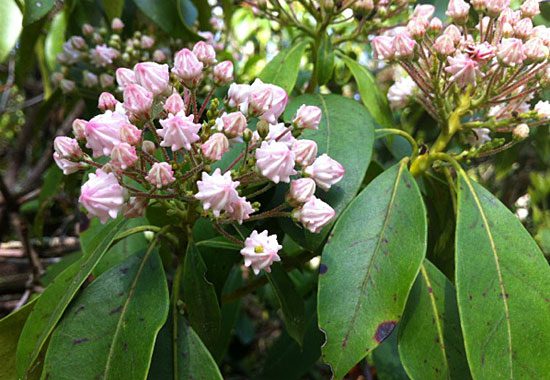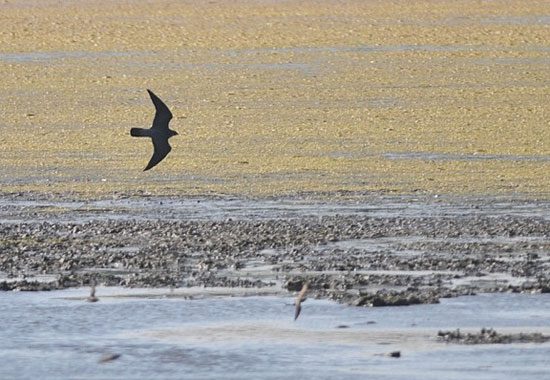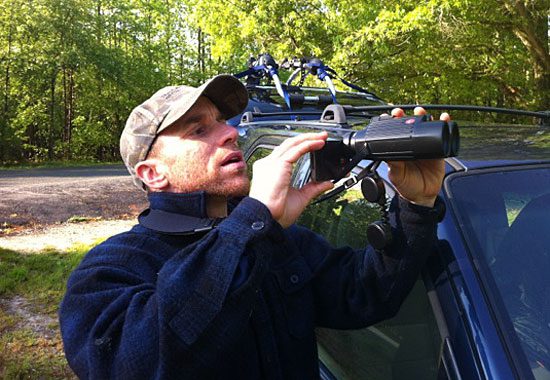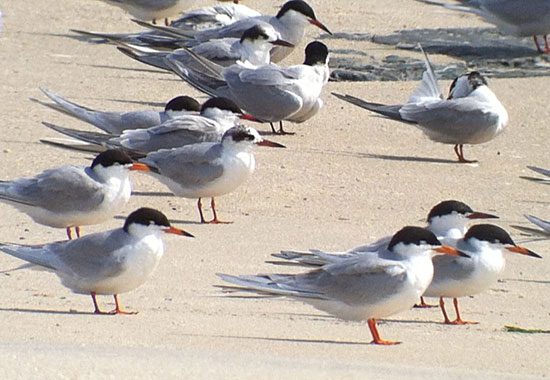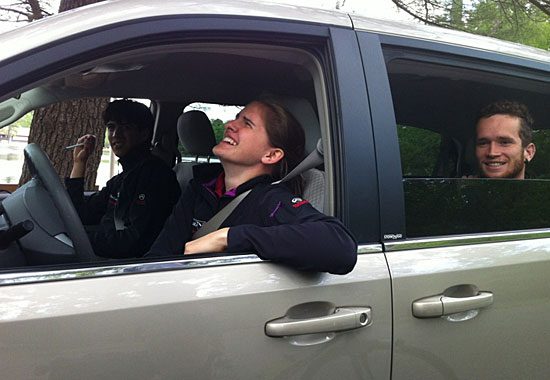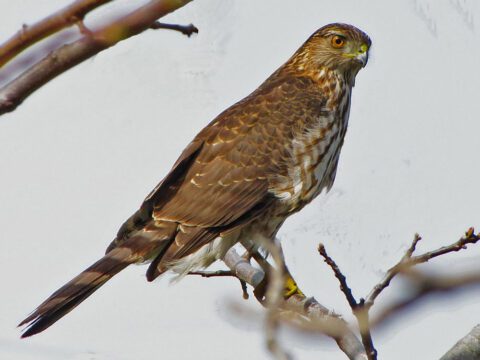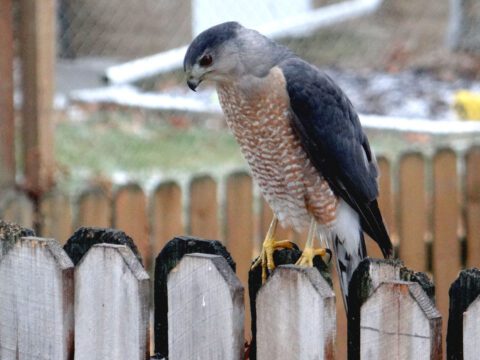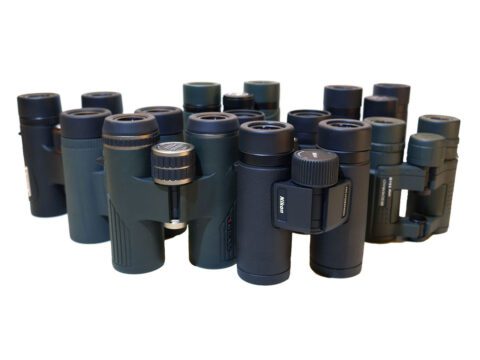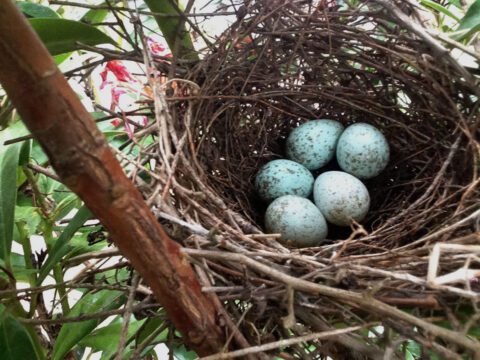Scouting Day 2: How to Scout for Warblers in New Jersey
By Hugh Powell May 10, 2012
A good warbler day can add upwards of 20 species to a team's total—so it's important to have a plan. 
Resident warblers sing from territories in Belleplain State Forest, where the mountain laurel is just coming into bloom. 
Our shorebirding was briefly interrupted by a Peregrine Falcon hunting at high speed. 
Charles Eldermire of the Anti-Petrels demonstrates how to take a photo with a phone and binoculars. 
Common and Forster's terns gathered at the beach at Cape May Point in the afternoon. 
Eric Gulson, Hope Batcheller (center), and Jack Hruska of Team Redhead recount their best birds of the day. 
With the sun setting in Cape May, we scanned the water one last time and prepared to go night scouting.
Here in New Jersey, the Anti-Petrels spent the morning refining our route for the dawn hours of the World Series of Birding on Saturday. The students of Team Redhead scouted saltmarshes, then headed inland to Belleplain State Forest’s warblers, tanagers, and woodpeckers before hitting Cape May to look for shorebirds and a rare Mississippi Kite. This close to the event, both teams are finalizing their routes, trying to link together the species they need without sinking too much time into travel.
Since we’re a bike-powered team, we have to minimize the amount of back-and-forth riding we do, particularly in the early morning when birds are most active and vocal. A 10-mile side trip by car isn’t a huge investment—but for us it’s close to an hour out of our day. So how do you balance all these concerns? Here’s a look at how our plan for warblers is coming together.
Warblers are one of the main attractions of spring birding—they’re brilliant, frenetic little jewels that come in a great variety, from the ubiquitous, like the Yellow or Yellow-rumped, to skulkers that you long to see, such as Cerulean, Connecticut, and others. Eastern North America has some 40 species of warblers, most of which are at least theoretically possible in southern New Jersey in mid-May. So if you’re looking to stretch your day’s bird list, warblers are essential to focus on. [Watch a Lab video about birding for warblers.]
We’re hoping to record somewhere between 12 and 30 species of warblers on Saturday. To make the task manageable, first we divide them into two categories: resident species that breed in southern New Jersey, and migrants that pass through. The difference between the two groups exemplifies the balance of patience vs serendipity it takes to make a big day work.
The two groups of birds behave differently: residents arrived a while ago and are spread out across the state. As long as we can find them, they’ll stay in the same place from day to day and (usually) sing late into the day. Residents in this part of the state include Yellow-throated, Hooded, Kentucky, Black-and-white, Prairie, Prothonotary, and nine other species. If we can get them all that’s 15 species on our quest for 150 or more total birds for the day—so it’s well worth putting in time to find singing males. This year, we’re worried about Kentucky Warblers, which seem even scarcer than usual. And we always worry about Louisiana Waterthrush: last year we burned 30 minutes waiting for a normally reliable bird to show up. (It never did.)
On the plus side, once we’ve found these breeding birds we can visit them later in the morning, since it takes less luck to find them. That frees up the most active hours (until about 8 a.m.) to look for birds we can’t predict: the migrants. These birds are on their way through the state to breeding grounds farther north. They fly at night, land to refuel for a day or two, and then head on out. The best way to find them is to look early in the morning in low, wooded habitat near the southern tip of the state—which is one reason why Cape May is a world-famous birding spot.
Migrants on a big day are a little like a bonus roll in Yahtzee—we know we’ll get some migrants to add to our base list, but it’s hard to know how many. Among the possibilities are Black-throated Green, Black-throated Blue, Chestnut-sided, Blackpoll, Blackburnian, and 10 others. Last year the World Series fell during a streak of poor migrant weather; we got only the most reliable of these including Black-throated Green, Black-throated Blue, and Blackpoll. But this year, the weather is looking more promising. Yesterday’s storm brought winds from the south (and several Mississippi Kites). Fair weather the next two days, coupled with winds from the west, could encourage a new wave of migrants to cross the bay from Delaware. As Redheads captain Hope Batcheller cautiously predicted in an email, “Migrants are going to be TOTALLY BOSS!!!”
So we spent the morning doing the next best thing to scouting migrants—and that’s scouting migrant habitat. Lots of car-powered teams head straight to Cape May for this; it’s one of the best migrant spots on the Eastern Seaboard. But on our bikes, we need to find our migrants within just a mile or two of where we’ll be at dawn, and also near Heislerville, our shorebird mecca (where we found a Stilt Sandpiper this morning, as well as two Peregrine Falcons. After a morning of searching, we found a grove of low trees, brush, and grasses near the bayshore. And the early results were promising: on an otherwise slow migrant day we found Blackpoll Warbler, Magnolia Warbler, Swainson’s Thrush, Scarlet Tanager, a migrating Eastern Wood-Pewee, and two lingering White-throated Sparrows.
Armed with a good plan for our morning, we’re back to looking for nighttime prospects such as Clapper and King rails, Least Bittern, Seaside and Swamp sparrows, and three owls (Great Horned, Barred, Eastern Screech). After jouncing down a washboarded road we’re deep inside Tuckahoe marsh. It’s a clear night with stars and city lights visible across the moonless reaches—and unfortunately very quiet. As I type, my teammates, France and Charles, bundle up against the chill and walk the road. But all they can hear is frogs. Night scouting has become the next thing to worry about. But thankfully, all the scouting will be over in about 24 hours, when the World Series begins. Thanks to everyone for following along!
(Thanks to Bob’s Red Mill for sponsoring the Anti-Petrels and Carl Zeiss Sports Optics for helping equip the Redheads. You can donate to support the teams here. Photos by Hugh Powell except Peregrine Falcon, by France Dewaghe.)

All About Birds
is a free resource
Available for everyone,
funded by donors like you
American Kestrel by Blair Dudeck / Macaulay Library

